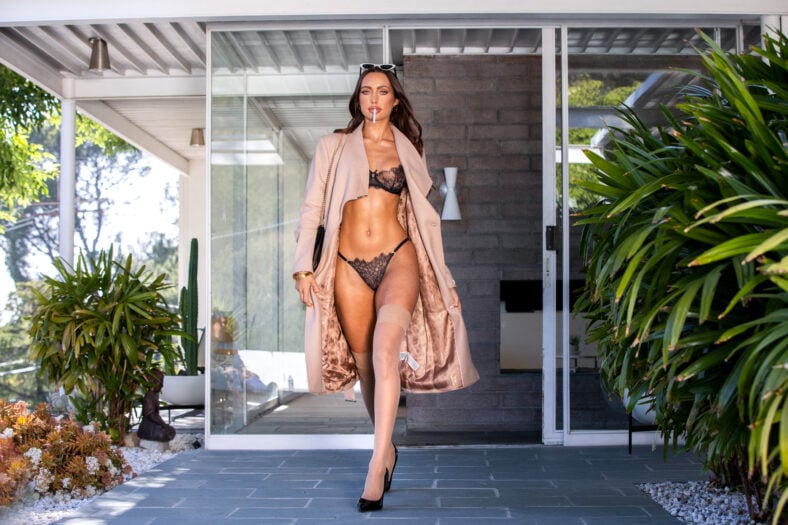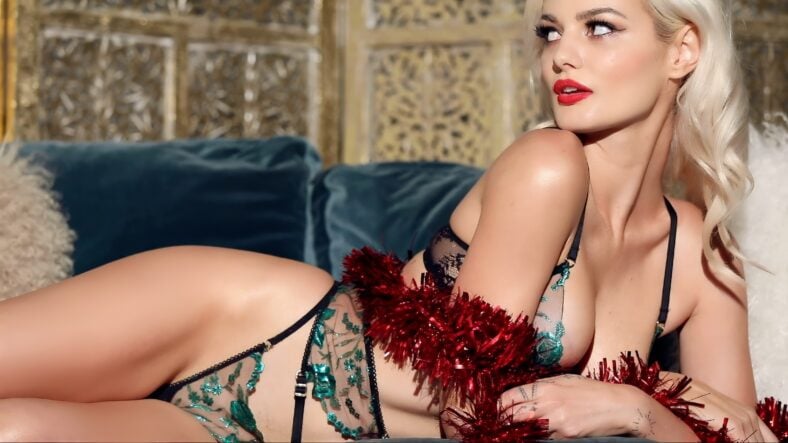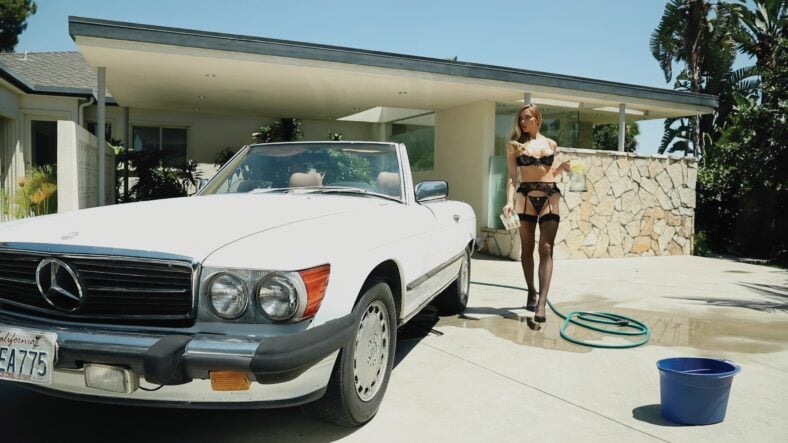
“Everyone has always said that I make people look better than they’ve ever looked.” In-demand commercial director Chris Applebaum takes the admirably modest “not-for-me-to-say” approach when asked what sets him apart from his peers, of which there are few. Applebaum’s combo of output and success is exceedingly rare, especially for a cameraman competing in Los Angeles, the industry’s most cutthroat locale. Chances are high that he’s helmed a music video you’ve watched on YouTube, directed a commercial you’ve seen on TV, or lensed a piece of alluring content that’s made you hungry (horn-gry, if you will). And looking at his filmography, it’s tough to deny the assessment that “everyone” has of his work: He makes people look their best.
Take his video for Miley Cyrus’s 2009 mega-hit “Party in the U.S.A.,” the lead single off of The Time Of Our Lives, her first EP. At that time, the former Hannah Montana star was just starting her transition from Disney Channel child actor to future pop music sensation, and her preferred attire was already causing friction with her soon-to-be-former bosses. “Miley had a really cool stylist who was set on bringing back jean shorts, back in 2010 before the trend exploded,” Applebaum says. “But Disney had a strict dress code for videos, and you needed to adhere to their guidelines for length of shorts. Miley walked out of her trailer with much shorter shorts. The shoot was massive, and I remember thinking Miley’s performances were amazing”—Applebaum made Cyrus look like a true superstar for the very first time by staging her Patton-style in front of a giant American flag with a vintage microphone. “Meanwhile, Disney execs were having a meltdown because the shorts they approved looked a lot shorter. There was even talk about digitally lengthening them, but the video has over a billion views, so I doubt Disney is complaining anymore.”
Helping an artist achieve a certain look in defiance of record executives is already a full measure. But a few years earlier, when Applebaum was working on the video for Rihanna’s chart-topping 2007 single “Umbrella,” he went to even greater lengths to bring an aesthetic vision to fruition. “The record label didn’t want to spend money on overages and acted like this was just another music video. I, however, was working closely with Rihanna. I saw her choreography rehearsals and wardrobe, and everyone who heard the song knew it was a massive hit. I wanted it to be special; I just threw my director’s fee at things like pyrotechnics to make the video better.” His sacrifice was undeniably worthwhile, as the “Umbrella” video currently boasts over 1 billion views on YouTube. “I simply believe that if you’re a real artist, you take chances,” Applebaum continues. “You stick up for what you believe in, and you prioritize the finished work more than a paycheck. Maybe things don’t work out, but maybe they do, and you create something that lasts forever.”
With that amount of artistic integrity, it’s no wonder that Applebaum’s resumé also includes music videos for Demi Lovato’s “Heart Attack” (834 million views on YouTube), Selena Gomez’s “Who Says” (409 million views), Semisonic’s “Closing Time” (130 million views plus MTV’s once-coveted annual Breakthrough Video award), and Kid Rock’s cover of Bad Company’s “Feel Like Makin’ Love.” The latter’s view count and fame are marginal by comparison, but its origin story is legendary. “I went to the studio to visit Kid Rock,” Applebaum recounts, “who put a 12-pack of Coors Light down and said, ‘We’re going to come up with a video concept before the case is finished, or I’ll just order another one.’ A week later, we were shooting on Larry Flynt’s private jet with [Kid Rock’s then-girlfriend] Pamela Anderson, who stopped by to give him a kiss for good luck.”
Though his music videos have billions of views, Applebaum’s most memorable work may be his commercials—those ads featuring an array of scantily clad beauties, including Paris Hilton, Kim Kardashian, Heidi Klum, Emily Ratajkowski, Padma Lakshmi and Nina Agdal. But there’s one supermodel (and former Maxim cover star) in particular who looked so good, the commercial helped launch her career.

“I pitched an unknown model named Kate Upton, who had a miniscule 3,000 followers on her socials. But I’d seen her dance ‘The Dougie’ at a basketball game and thought she was a star. If she wasn’t the next big thing, I vowed to resign and let someone else direct the commercials. Within three days of releasing the director’s cut of Upton’s commercial on YouTube, it had racked up 3 billion views,” Applebaum says, though that video appears to have since been scrubbed. “Needless to say, I didn’t lose my job.”
That campaign’s success helped inform Applebaum’s next project, an Instagram account formed in 2016 and dedicated to even racier videos that synthesize delicious food and feminine beauty. As he continues to hone this style and concept to perfection, Eats (@eats.channel) has become Applebaum’s biggest success yet by view count, with over 7 billion combined plays and counting. “The concept was to establish the brand on social media and tap into a new wave of talent that were being called ‘influencers.’ Instagram didn’t have the same restrictions as broadcast TV, so Eats could be sexier. But it was also about female empowerment and taking an approach to avoid objectification; I let models pick what they want to wear, what they want to eat and give them the final edit. If there were shots they disliked, the policy is to remove them—no questions asked.”

While Applebaum can hang his hat on any one of these projects, his immediate plans are to continue feeding fans Eats clips while he develops a TV show chronicling the history of music videos: “If you find any of my stories about making videos interesting, then this is a series you’ll enjoy.” Regarding the long term, he says, “The great Italian director Michelangelo Antonioni directed films into his 80s. Martin Scorsese was 70 when he made The Wolf of Wall Street. Directing is great because when you get older, all you need to do is sit in a chair, point, and tell people what to do. They have people who bring you fresh coffee whenever you ask for it, so why would I ever want to do anything else?”
Tell us a little about yourself. What was your early life like, and how did your experiences shape your perspective as an artist, director and photographer?
When I was 12, my parents got divorced, and my neighbor across the street gave me a video camera to help me take my mind off things. It shifted my focus elsewhere. I made my first “movie” when I was 12 and a couple years later I got MTV. I stayed in my room watching it all day and all night. On one MTV News segment, the VJ was interviewing Duran Duran, and when asked how they come up with video concepts, they said they would blindfold themselves, spin a globe, and wherever their finger landed is where they would shoot. Cut to: the band running through tropical jungles in Asia, on the front mast of a schooner breaking through deep turquoise waters in Martinique, Simon Le Bon dying of thirst lying on an ancient statue in Sri Lanka as a local boy squeezes excess water from a rag into his parched mouth. For any aunt or uncle asking what I wanted to be when I grew up, I finally had an answer.

In an old Videostatic interview, you mentioned that you got your first gig shooting a music video by cold-calling a record company. Do you think that tactic would work today?
The three components of success have remained the same: hard work, perseverance and luck. When I went to college in Amherst, Massachusetts the alternative rock scene was really taking off, and being a college town, all the bands would roll through. So I would go backstage after the shows and ask bands if I could shoot their music videos. Bands like Nirvana, Soundgarden, Sonic Youth, etc. At that time, most thought it was cute an 18-year-old kid was approaching them, or maybe they just liked that I’d take beer and food as a welcoming gesture. Krist Novoselic from Nirvana was the exception; he took a fresh large cheese pizza and threw it in the air—it suction-cup stuck to the ceiling.
Since this approach didn’t work very well, I went through a Northampton record store and wrote a list of all the record labels that existed at the time, cold-calling each one to speak to their video department. When I called Mercury Records, the video commissioner had just hung up with a director who was backing out of a scheduled video for Material Issue. She asked me if I could shoot in vie days for $10,000 and I said yes. That’s how I got my first music video. It was pure luck. Could this tactic work today? Sure. There’s always someone who wins a Powerball lottery. But that was only one video. Shortly afterwards, the video played on the (MTV’s) cult-classic 120 Minutes at 2:00 a.m. on a Sunday night as the credits were rolling. I got a call in my dorm the next day from the head of on-air promos at MTV. That was the department that did all the coolest visual content at the channel—those short 3 to 5 second interstitials with an MTV logo over them. I got offered an internship there and took the bus back and forth to New York every week, finishing classes then going to do 12-hour workdays at MTV. That’s a whole other collection of great stories, but it gave me extra juice when I met bands. I could tell them I worked at MTV and that I could just walk their video up to 120 Minutes if they let me direct for them. That’s not how programming at MTV worked, but it gave me an edge of confidence approaching cool bands back in the day.
On another note, my dormmate at college was Nate Albert, who was the lead guitarist from the Mighty Mighty Bosstones. Late at night, we would muse that one day his band would have a major-label deal, and I would be their video director. I ended up shooting a bunch of smaller videos for them, but when they get signed to Mercury Records, the band suggested their old friend to direct their big single for “The Impression That I Get.” There were new people at the label and they wanted a really big director, not the band’s friend from college. The band fought hard for me, saying they wanted a director that truly understood them. The budget was $200,000 but the label said that if I was their choice they’d need to cut it to $100,000. That way they could have some reserve money for when this little experiment was over and they needed to re-shoot the video entirely. To do the video for half the price I had to chip in my entire director’s fee to afford it.
But I did and I made a deal with Mercury Records that if the video went into heavy rotation on MTV they needed to pay me my entire fee, which they’d obviously be able to afford since I was essentially saving them $100,000. While I was shooting the video, the [artists and repertoire) woman from the label kept pulling band members aside to read video treatments submitted by the big-name directors. They were literally planning the re-shoot, expecting me to fail while we were shooting the video. A week after the video debuted on MTV, it shot up to heavy rotation, eventually going to No. 1. And a week after that, Mercury Records sent me a sizable check for my fee.
The list of artists you’ve shot music videos for is staggering: Hilary Duff, Ween, Rihanna, Usher, Demi Lovato, Selena Gomez, Miley Cyrus, etc. Which experiences do you look back most fondly on?
I’ve already told the story of how Justin Timberlake broke up with Britney Spears on our video shoot and I went into her trailer and got her to come back on set by suggesting she show him that he just fucked up the best thing he’s ever had. But I’ve had some amazing experiences. I love that I’ve seen Michael Stipe from R.E.M. holding up the shoot because he’s engrossed in a conversation with the Craft Service lady (the second-lowest-paid person on a film shoot).
I sat with Jay-Z and Rihanna at the Beverly Wilshire for lunch, and Jay said he wanted me to sprinkle heavy symbology throughout the “Umbrella” video, which ended up inspiring the modern obsession with the Illuminati. I went to Prince’s fabled purple mansion in Beverly Hills for a meeting, and after an hour-and-a-half of talking about his video concept he said, “Let me try to explain this another way…” We took an elevator up to the top floor to reveal a massive ballroom where, no shit, ten musicians were set up, sitting on stools like it was their post. I’m not exaggerating, within five seconds Prince had his guitar on, called out, “5-6-7-8,” and they launched into the song. At different parts he’d speak into the mic: “This is where I want the skies to open up, Chris” which I observed as twin Australian female contortionists freestyled a routine off to the side. I also loved the video for Semisonic’s “Closing Time”—a particularly difficult video to shoot because it was all in two takes without edits (one for the R screen and one for the L screen). We all (crew, band and record label) stayed for three hours after the shoot in a dim, industrial parking lot in downtown L.A. because we were all so excited for having pulled off something that had never been done before.
There’s other fun stuff, like when Rachel Hunter pulled up to set on the [Fountains of Wayne’s] “Stacy’s Mom” video in a $300,000 Aston Martin, the kid actors were blown away. It was the perfect reaction, so I quickly brought the camera around and had them repeat it again. When I directed Mariah Carey, I remember waiting anxiously for her rider to come through via email. Known for having eccentric riders, I was in heaven reading all the things she demanded we furnish for her shoot, like champagne and drinking straws, the exact temperature she needed for her motorhome, etc. When I met her in Honolulu for the shoot, she greeted me in a Moroccan day bed draped in pastel chiffon as she sat there in acid-washed short shorts (shorter than Miley’s!), petting a part of the bed as a motion for me to sit down and join her. As soon as I started talking she fell asleep. Ha!
What’s the key to being a successful director in 2025?
The challenge for anyone who wants to be successful in 2025 is to remember two things: Success isn’t measured by how big a splash you make today, it’s from a string of consistent hits over an extended period of time. So what if your video went viral. Does it have 1 billion views? And do you have more than a couple billion hits over the course of several years? Today’s TikTok and Instagram generation have created a false sense of success. A couple of viral videos make people think they’re superstars. From my perspective, I’ve seen this play out for decades. I’d see a music video director make a hit video and they’re the flavor of the week. Nothing can stop them. But if they can’t sustain that level of success over a long period of time they fade into obscurity. Plus, 50 percent of success is how you gauge success within yourself. You need an external source to acknowledge that you’ve done a good job, but the common thread among the most successful people I’ve met is to have that external acknowledgement married with a deep drive within yourself to become better and a genuine love for what you’re doing. Those people don’t quit when they’ve “made it” and always strive to hone their craft, learn new things, and create because they genuinely enjoy it.

Secondly, remember that technology is never going to make you better. Once you learn how to master shooting a pro camera, a new, better one comes out. Or a fancier light. Sure, the technology will help you cut down on the amount of time it takes to achieve your creative goal, but you don’t win because of the technology. At a certain point, everybody has access to the same technical information and equipment. The question is: What do you do with it? What do you create?
Any big projects that you’re working on currently?
Aside from Eats, I have a T.V. show in development that’s about the history of music videos. If you find any of my stories about making videos interesting, then this is a series you’ll enjoy.